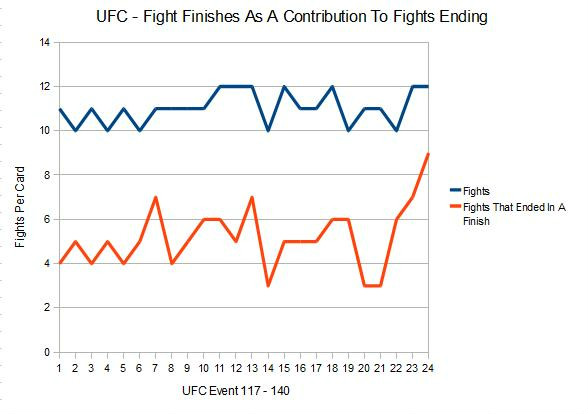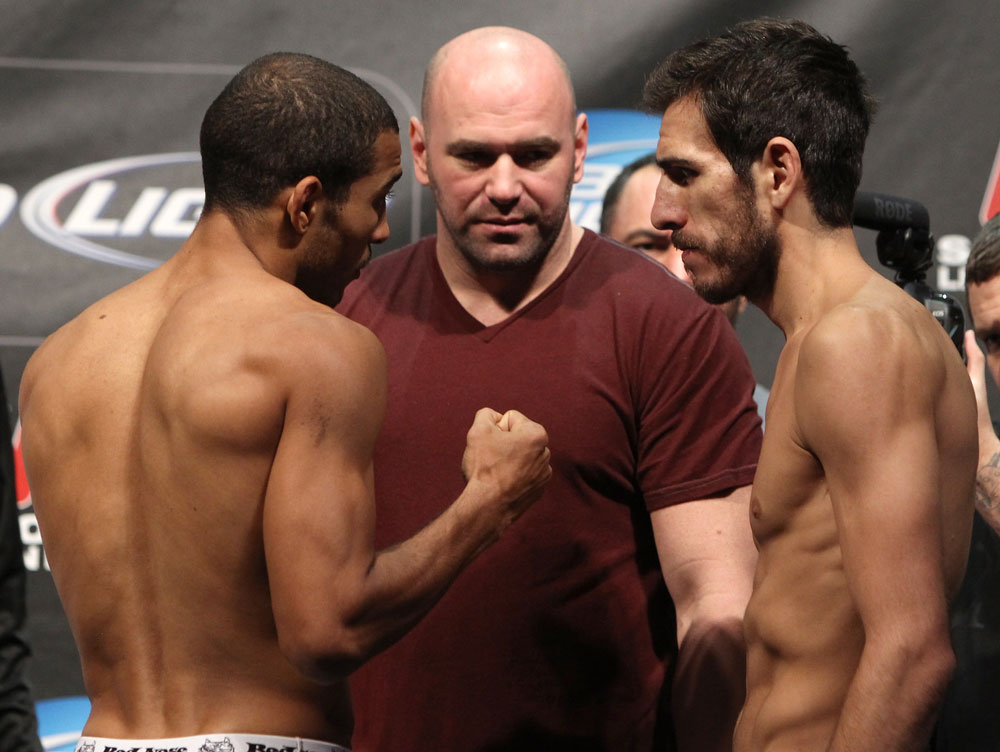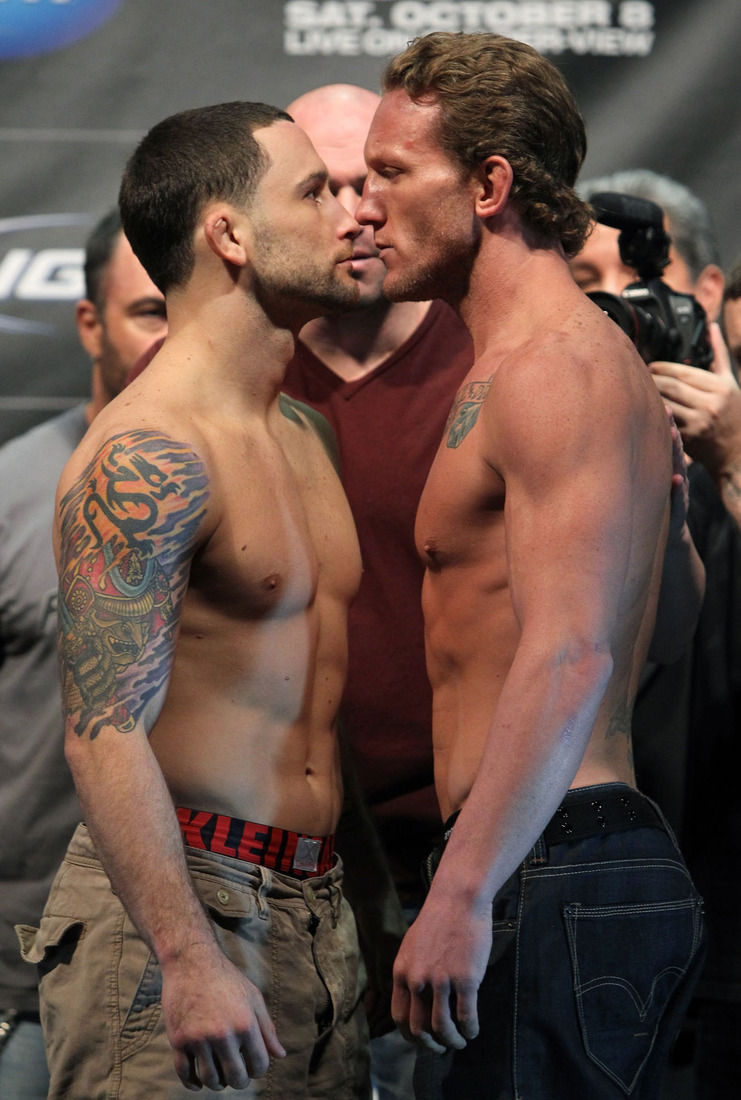Yet one thing that immediately stuck out to me upon witnessing Jon Jones submission victory over Lyoto Machida was the utility that Jones approaches fights with. Out of ten fights in the UFC, only two have gone to decision (both of which were his first two fights in the Octagon). Out of eight finishes, six ended within three rounds. Yet outside of stating Jones' phenomenal UFC finishing rate (80%) it is the trend Jones is starting to establish for finishing fights very quickly, and without a lot of purposeful and planned set-up, is what I am hoping to prove here. Both of his victories over Ryan Bader and Machida ended in modified guillotines as a result of punches, yet it was obvious that it was not Jones' plan to wobble those opponents then secure the choke, particularly chokes that were as modified as they were. That is not to say that Jones did not have a game plan, far from it, but that his game plan provided that he could finish his opponents by way of (T)KO or submission. This is in often direct contrast to fighters who have a specific game plan that accounts for finishing opponents (very briefly: Michael Bisping, stick-and-move for a (T)KO or points decision; Dan Henderson, giant right hand; Anderson Silva, decides before the fight and then does it, etcetc).
Furthermore out of Jones' eight finishes fully half were submissions, three of those guillotines. In a vacuum those statistics are not particularly impressive or even interesting. However when compared with the UFC as a whole a clearer picture of the astonishing nature of Jones' MMA game appears. Over at Bloody Elbow blog member Numbers posted a fantastic post (which I recommend everyone reading) on the trend of fight finishes in the UFC since the Zuffa take over at UFC 31 until UFC 116. Through a statistical analysis of the method of how fights finished Numbers discovered that as a whole, submissions in the UFC since the Zuffa take over have been subjected to a gradual decline apart from a peak during around Autumn 2007. As a graph it is represented as thus:
(Graph courtesy of Numbers at Bloody Elbow)
It becomes clearer to see as a trend line:
(Graph courtesy of Numbers at Bloody Elbow)
Numbers correctly identifies to queries from these numbers, "(1) What could explain this trend, and (2) Can it be considered "good", "bad", or maybe neither?" However, I am not concerned with the implications of what these numbers mean so I implore you to check out the original post. Numbers then continues his analysis of finishing statistic to show that (T)KO's displayed "a trend line shaped opposite of, but less pronounced than, that of submissions":
(Graph courtesy of Numbers at Bloody Elbow)
Finally, a look at the result of decision finishes in the UFC provides another interesting result:
(Graph courtesy of Numbers at Bloody Elbow)
Quoting Numbers at length, we find that,
This is no reversion to the mean or a flattening out. There is a
clear-cut increase in decisions over the past five years. Taking all of
this information cumulatively, it's most accurate to characterize the
situation this way: It's not so much that submissions have declined, as
a statement without context, but that decisions are dramatically up and
both forms of stoppage are down, with submissions compromising only a
slightly larger proportion of the reduction.
So to sum up what we have discovered so far, it is that submissions are falling, (T)KO's have stayed roughly the same, and decisions are on the increase. Continuing the statistical analysis from UFC 117 until UFC 140 we see the trends discussed so far remain the same.
As you will soon realise, I am terrible at making graphs and so have done a much simplified version of the kind Numbers has done:
This time I have taken the liberty of assuming that the trends already established by Numbers in terms of percentage of fights finished will have remained the same (especially as I am analysing a much shorter time period). What I have produced is a graph showing how much submissions make up the overall percentage of fight finishes. As we can see submissions make up under half of overall finishes, thus conforming to the trends established by Numbers (of course with a couple of exceptions).
So how does this relate to Jon Jones? Well, as previously stated Jon Jones has a finishing rate of 80%, compared to a UFC average of around 45% (computed from an analysis of fights from UFC 117 through 140). As a horrible graph it can be expressed as:
What's that? You want another terrible graph showing how Jon Jones compares to this?
As we can see, comparing the two serves to highlight how remarkable Jones is compared to the majority of the UFC. But not only that, Jones finishes his fights with a 50% split between submissions and (T)KO's (it's okay, I won't put that statistic a a graph).
An interesting note is the submissions Jones uses. Three of his submissions have come via guillotine, a technique one would safely assume is ubiquitous as far as submissions go. However an analysis of guillotines as a contribution to overall submission finishes, between UFC 117 - 140 shows us:
Surprisingly, and against common MMA intuition, guillotines, despite perhaps being the most economical of all submissions, makes up a surprisingly small percentage of overall submission finishes. Yet for Jon Jones, the guillotines technique makes up 75% (no graph!).
So what in the name of poor graphics am I finally trying to say? Ultimately that Jon Jones has both a finishing ability way above the UFC average, and that his methods of finishing utilise an incredible utility. Of course this final assertion rests on my assumption that the guillotine choke, requiring a simple application of pressure to either side of the neck and is viable from any position, is the simplest of all submission techniques. Taking this as true, it highlights how Jon Jones has been able to secure such a meteoric rise in the UFC. Utilising his incredible strength, aggression and reach, he uses these to dictate each fight. Then most importantly when an opportunity to finish the fight presents itself Jones takes immediate advantage of it. I think I can safely say of all the ways to defeat Machida, no one would have picked the standing guillotine. But Jones, having realised how simply the guillotine choke can be applied, simply held Machida up against the fence and squeezed his neck until Machida passed out. Short of punching an opponent as hard as possible in the face resulting in a KO, this is the easiest and quickest way to defeat an opponent, and Jones has done this on three separate occasions. The astute amongst you will have made the connection that a few other successful fighters (Overeem and Ben Henderson to name a couple) also use the guillotine to great effect and are currently scheduled to fight for UFC titles. Lest I appear to be making an incredibly poor argument, this finishing utility also extends to the BJJ world championships. Roger Gracie, the most successful champion in the BJJ World Championships has won the majority of his fights via Cross Choke, the most simple submission in Gi-BJJ.
The ability to reduce a fight to its most simple processes is one of the major ingredients in what separates a fighter and a championship fighter.










